Dome Control
The domes at Moore and Mt. Kent observatories have their own control systems designed to interface with the electromechanical hardware supplied by the dome manufacturer. The esstential design elements shared by all domes are
- Rotation encoder
- Rotation motor controller
- Shutter motor controller
- Software connected to the telescope control system
Additionally, some domes have environmental and shutter status monitors.
This page is a description of the dome control hardware and software highlighting similarities and differences between the systems for the various telescope enclosures at Moore and Mt. Kent observatories.
Rotation Encoder
We use an RFID tag encoder that senses tags attached to the inside perimeter of a dome. On the CDK20 Sirius domes, the tags are attached to the gear drive rail as shown here:
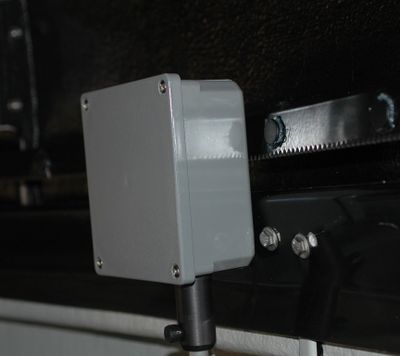
The tags on CDK20N are 4 degrees apart. Each tag has a unique identifying code. When the dome rotates and brings a tag into the sensing space of a tag reader, software traps the tag event and identifies the dome azimuth angle based on a map of tags to angle that is saved for each dome.
The tag readers are from Phidgets, a company that makes USB-interfaced hardware for electronics hobbiest. They supply an OpenSource library that enables us to include the tag reader in the dome control software.
Software
Dome rotation software has been written in C and Python to communicate with the telescope control software in an observatory operations package. New code being developed also offers a connection to other processes through XPA.
- PyDome scripted control interfaces with telescope and camera operations for automated dome tracking during long exposure sequences
More information is available on the Shared Skies software page.
Sirius Domes for CDK20N and CDK20S
The original Sirius electronics controls dome rotation and the opening and closure of the upper and lower shutters through manually operated switches. The control board is proprietary, but its operation is determined by wiring to screw terminals that we have modified to connect to external digital systems. The common schematic for rotation and shutters at both sites is shown here:
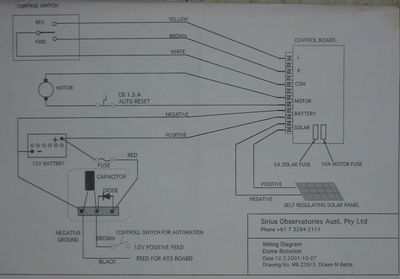
A switch applies 12 VDC power to one of two lines that select the direction of rotation, or similarly open or close the two shutters. In computer controlled operation there is a relay system in parallel with the manual switch, such as shown here:
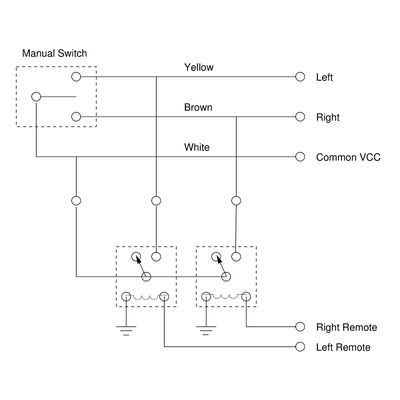
with the power for the relays provided by the "COM" 12 VDC power of the dome electronics. Note that "COM" is not ground, but the common 12VDC from the battery power of the system. Fuses and circuit breakers protect the motors from overload, and the control board is designed so that most operations are safe. In this respect, there are limit switches on the shutter motion that turn off power to the motors when the shutters are fully open or closed. There is no hard-wired logic to insure that the lower shutter is closed before the upper shutter drops down over it, however.
At the CDK20N we have a relay box mounted on the dome wall containing 6 socketed industrial relays with 12 VDC coils. The relays are wired such that the application of the "COM" voltage to a control line causes the relay to close with the same effect as the corresponding switch.
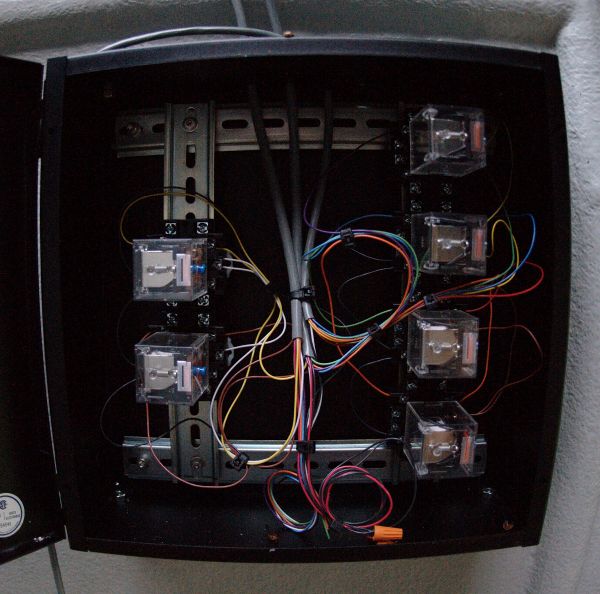
The relay box is hardwired to the dome rotation electronics, and may also be hardwired to the shutter electronics though a dropline to the rotating dome. The line falls at the perimeter of the dome and may sweep 180 degrees in either direction from south, largely free of obstruction. However, the dropline is connected through an 8-pin Phoenix Contact connector that will pull apart if the cable is caught.
Alternatively, a National Control Devices MirC Wi-Fi relay mirror is used which accepts contact closures from the same Phoenix connector as input, and trips relays on a mirror card at the shutter electronics module. This system eliminates the possibility of that the cable will detach in remote operation. However it also uses more power from the dome solar powered battery.
The master relay box is controlled by a Digital-Loggers Web Din Relay shown here:
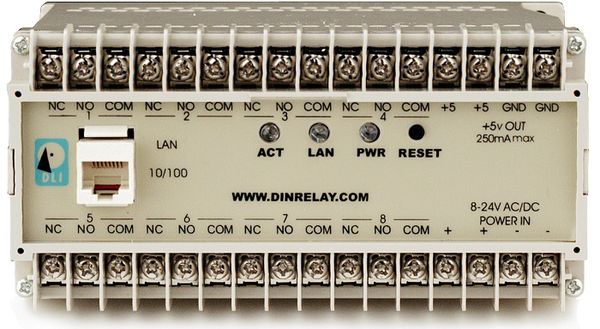
The device provides a robust configurable interface that enables web-based control of the dome shutters and rotation. Since it runs its own internal server. interfacing with it is simple through TCP/IP over port 80.
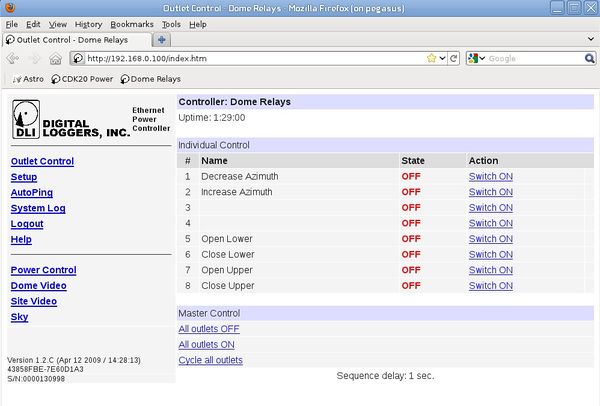
Each labelled relay controls a single normally open line, and connects to the dome 12 VDC system to switch on that function. The lines are color coded, and connected by a 9-wire cable that is terminated with a Phoenix Contact connector close to the DIN controller:
- Rotate CW (decrease azimuth) - yellow to relay 1
- Rotate CCD (increase azimuth) - brown to relay 2
- Open Upper - orange to relay 7
- Close Upper - green to relay 8
- Open lower - blue to relay 5
- Close lower - violet to relay 6
This relay order leaves a safe gap on the user interface between shutter and dome rotation. It also avoids relay 3 which, on the module in the CDK20N dome, may have a high resistance contact.
Sirius Shutter Control at CDK20S
At Mt. Kent the shutter control is wireless and utilizes a system designed by Dr. Rhodes Hart incorporating a solar-powered microcontroller. The controller manages TCP/IP communications through a secure wireless network accessible to remote observers and to observatory control software. Since it is aware of the environment, and requires a heartbeat signal from the observatory watchdog program, it will automatically close the dome should communications or mains power failures occur. It can be programmed to be aware of the rain and dew sensors as well. Addtional details on this controller, which has been duplicated for use in all the enclosures at Mt. Kent, will be provided on another page. Fundamentally it takes on the same role as the relay mirror used in the CDK20N dome, with the addition of monitoring for telescope safety.
RC24 Ash Dome
The larger Ash dome enclosing the Moore RC24 (MORC24) telescope requires 220V power for rotation and for shutters. The rotation control is through a DIN relay system and modular relays similar to that used for the Sirius domes, except the wiring mimics a manual AC motor drum switch. One relay sets direction and another relay toggles the mains power on and off. The same pattern is used to open and close the shutter through a dropline.